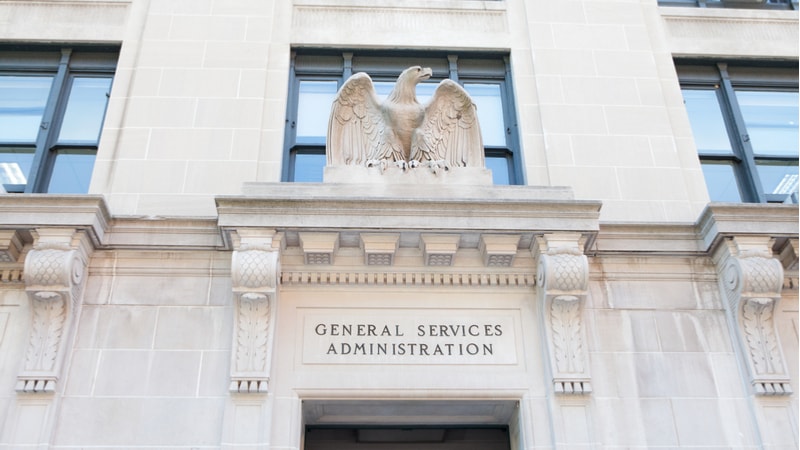
The General Services Administration’s five-year strategic plan published on March 31 weaves the developing issues of telework, cybersecurity, IT-driven citizen service improvements, and adoption of further acquisition technologies throughout much of the agency’s wide-ranging work plans for fiscal years 2022 through 2026.
From a top-level view, the agency outlined the goals of its five-year plan for delivering “the best customer experience and value in real estate, acquisition, and technology services to the government and the American people.” To accomplish that mission, GSA said it will enhance the delivery of its products and services by:
- Developing solutions with the end-user in mind to make it easier and faster to work with GSA;
- Using technology and innovation in real estate and acquisition to transform the business of government;
- Offering equitable and sustainable solutions;
- Enabling the Federal government to operate more efficiently and effectively, allowing agencies to focus on their mission; and
- Serving as a champion for interagency collaboration, with a focus on continually growing and improving people, policies, and processes.
Telework Evolution
GSA said it will manage its vast portfolio of Federally owned and leased real estate with the still-evolving practices of telework in mind, although the agency offered no hard and fast estimates of how that may impact its total real estate portfolio.
“Workspace allocated per person is likely decreasing, a long-term trend accelerated by the COVID-19 pandemic,” GSA said. “The pandemic demonstrated that telework is a viable option for most Federal agencies and that the future will include a mix of office-based work and telework.”
“This presents a unique opportunity to restructure GSA’s real estate portfolio and meet customers’ workplace needs through a combination of space and technology services,” the agency said. “While office trends might change the composition and size of the GSA real estate portfolio in the future, GSA will continue to manage a significant asset base,” the agency said, which will include addressing “a growing backlog of deferred maintenance.”
Elsewhere in the planning document, GSA said aims to “right-size the GSA portfolio and sustain a financially viable real estate model that supports the President’s Management Agenda by partnering with customer agencies to optimize future space requirements.”
“GSA is proactively collaborating with agencies to determine what the future of the workplace will look like, and the potential for cost savings derived from thoughtful practices and space design,” the agency said, adding it will “continue to use a data-driven approach to gain insight into agencies’ future operating postures and real estate needs, recognizing that each customer will have different requirements.”
The agency also talked about its Workplace 2030 initiative which is led by GSA and involves multiple agencies, and that aims to identify “the set of real estate, technology, and people solutions required and desired in the Federal workplace of the future.”
“Based on efforts to date, GSA is simplifying the purchase of home office furnishings and technology for customers, creating a Workplace Innovation Lab that will allow customers to experiment with emerging workspace technologies, and actively offering flexible co-working space through a contract with multiple vendors,” the agency said.
Eyes on Cyber, IT Improvements
GSA listed four “fundamental strategies” it will pursue to deliver on its mission over the five-year plan, with cybersecurity and IT improvements high on that list, including in the area of acquisition-related tech.
Among the four strategies, GSA said it aims to:
- “Modernize technology across Government to protect against cyber threats and deliver a better digital experience for the American people”;
- “Promote interagency collaboration, centralized services, and shared solutions to improve management practices and operations across government”; and
- “Offer best value and an exceptional customer experience” to Federal organizations acquiring professional services, IT, and telecom services.
Under the digital government heading, GSA said it is “positioned to create transformative change across Government as agencies modernize and secure Federal IT and Federal networks.”
“Driven to make an impact, GSA’s technology offices — Technology Transformation Services (TTS) and the Office of Information Technology Category (ITC), supported by the Office of Government-wide Policy — are leading the digital ecosystem in the Federal Government,” the agency said. “They are committed to deepening Government-wide capabilities and services to yield a trusted, accessible, and user-centered digital experience.”
“Technology is at the foundation of all of the Administration’s priorities: addressing the COVID-19 pandemic; promoting economic recovery; advancing diversity, equity, inclusion, and accessibility; and tackling the climate crisis,” the agency said. “More specifically, the pandemic has revealed and underscored the need for improvements in how the Government must use technology to improve service delivery. The nation’s response to the pandemic was hindered by legacy systems and compounded by clear digital inequalities. Agencies have an obligation to rebuild public trust and to improve mission delivery through digital services.”
Tying into the Biden administration’s push for improved digital service delivery to citizens, GSA said it is “well-positioned to deliver meaningful advancements by supporting agencies in their journeys and prioritizing the development of common digital services and standards, platforms, and products.”
“Programs such as the United States Web Design System, Login.gov, and USAGov are examples of GSA’s ability to deliver increased efficiency, integration, and improved service delivery for human life experiences – ‘the moments that matter most in people’s lives,’” the agency said.
Acquisition Automation
On the acquisition front, the agency said it is committed to modernizing acquisition through the use of technology and automation. The agency’s five-year plan features:
- Delivering a modern, enterprise-wide Contract Acquisition Lifecycle Management (CALM) system to streamline acquisition systems;
- Merging legacy applications under the Assisted Services Shared Information System (ASSIST) to provide users with a single experience for all GSA Assisted Acquisitions;
- Automating bots to produce time savings and/or increase quality through error detection; and
- Streamlining and improving data management for the more than 50 million products and services offered to the Federal marketplace through Catalog Management.
